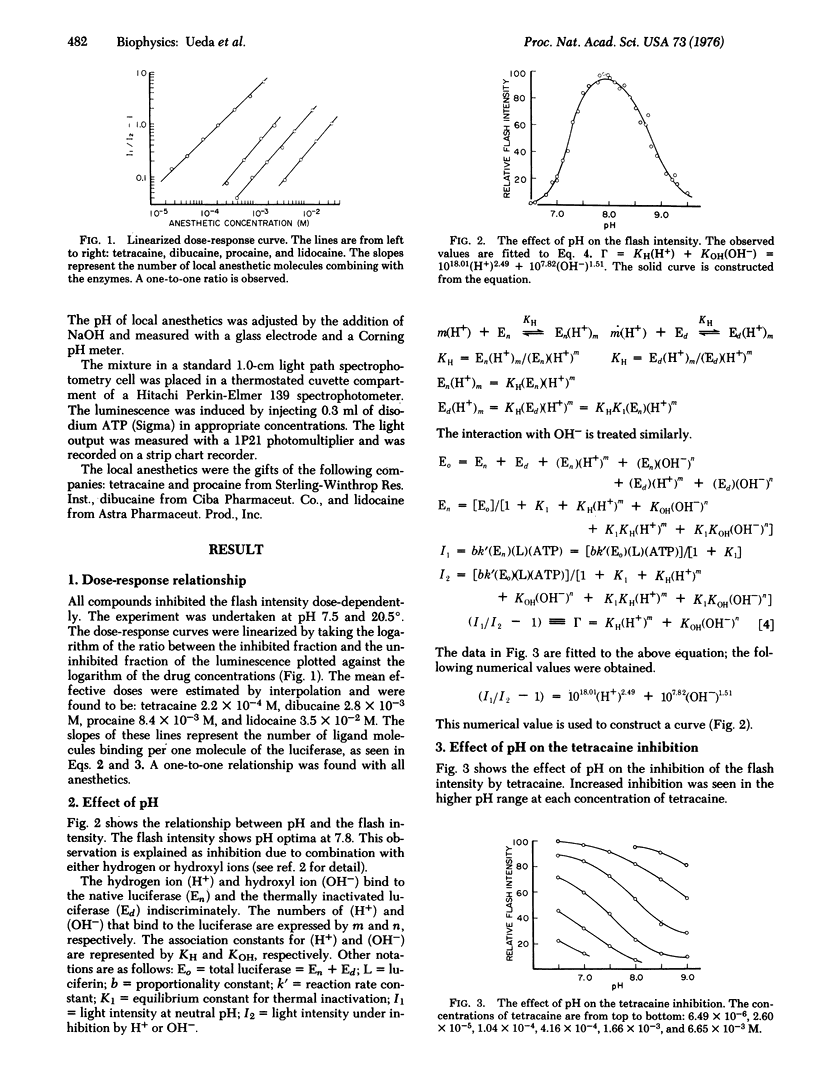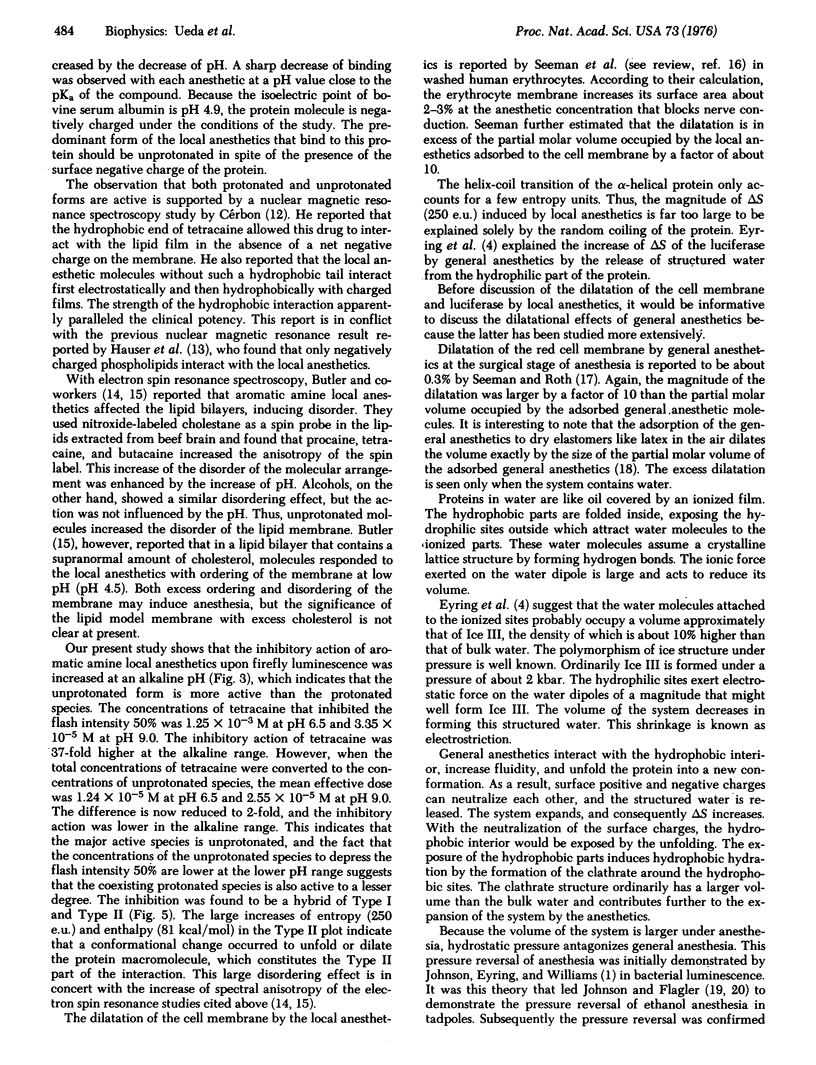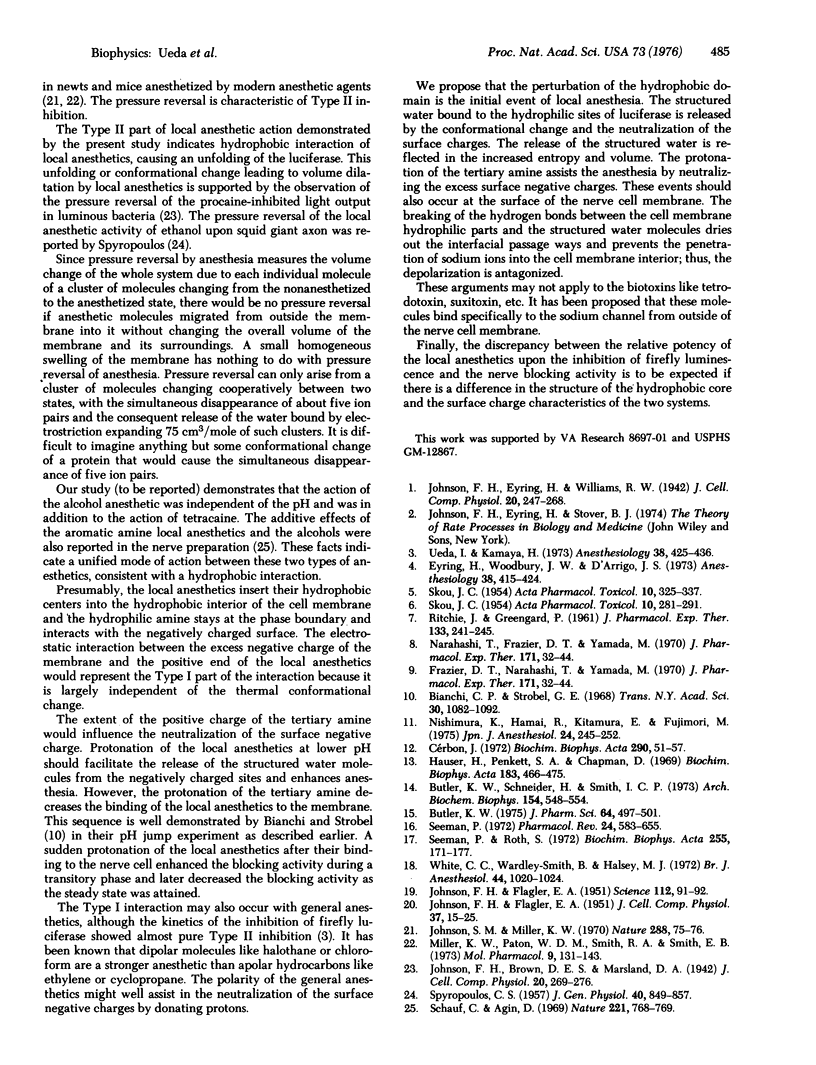Abstract
The kinetics of the action of local anesthetics upon firefly luciferin and luciferase systems is presented. Clinical concentrations of local anesthetics inhibited this ATP-induced luminescence in a dose-dependent manner. From the effects of temperature and pH upon the inhibitory action of the local anesthetics, it is concluded that hydrophobic ligand-enzyme interaction is the predominant cause of the inhibition, but hydrophilic interaction also contributes to the inhibition to a lesser degree. A molecular theory of anesthesia is outlined which postulates that release of electrostricted water molecules from the hydrophilic parts of the enzyme due to the protein conformational changes induced by anesthetics is the cause of the decreased luminescence. A similar mechanism is expected to occur at the cell membrane, which probably dehydrates the sodium channel and suppresses the conductance of this ion across the membrane. These events lead to a volume expansion of the total system, and the system becomes reactive to a pressure which reverses the anesthesia by shifting the equilibrium to the nonanesthetized original volume. The pressure antagonism of anesthesia can be explained by this overall volume expansion and not by a mere swelling of the cell membrane.
Full text
PDF




Selected References
These references are in PubMed. This may not be the complete list of references from this article.
- Blanchi C. P., Strobel G. E. Modes of action of local anesthetics in nerve and muscle in relation to their uptake and distribution. Trans N Y Acad Sci. 1968 Jun;30(8):1082–1092. doi: 10.1111/j.2164-0947.1968.tb02557.x. [DOI] [PubMed] [Google Scholar]
- Butler K. W. Drug-biomolecule interactions: spin-probe study of effects of anesthetics on membrane lipids. J Pharm Sci. 1975 Mar;64(3):497–501. doi: 10.1002/jps.2600640339. [DOI] [PubMed] [Google Scholar]
- Butler K. W., Schneider H., Smith I. C. The effects of local anesthetics on lipid multilayers. A spin probe study. Arch Biochem Biophys. 1973 Feb;154(2):548–554. doi: 10.1016/0003-9861(73)90007-6. [DOI] [PubMed] [Google Scholar]
- Eyring H., Woodbury J. W., D'Arrigo J. S. A molecular mechanism of general anesthesia. Anesthesiology. 1973 May;38(5):415–424. doi: 10.1097/00000542-197305000-00001. [DOI] [PubMed] [Google Scholar]
- Hauser H., Penkett S. A., Chapman D. Nuclear magnetic resonance spectroscopic studies of procaine hydrochloride and tetracaine hydrochloride at lipid-water interfaces. Biochim Biophys Acta. 1969;183(3):466–475. doi: 10.1016/0005-2736(69)90161-8. [DOI] [PubMed] [Google Scholar]
- JOHNSON F. H., FLAGLER E. A. Activity of narcotized amphibian larvae under hydrostatic pressure. J Cell Physiol. 1951 Feb;37(1):15–25. doi: 10.1002/jcp.1030370103. [DOI] [PubMed] [Google Scholar]
- JOHNSON F. H., FLAGLER E. A. Hydrostatic pressure reversal of narcosis in tadpoles. Science. 1950 Jul 21;112(2899):91–92. doi: 10.1126/science.112.2899.91-a. [DOI] [PubMed] [Google Scholar]
- Johnson S. M., Miller K. W. Antagonism of pressure and anaesthesia. Nature. 1970 Oct 3;228(5266):75–76. doi: 10.1038/228075b0. [DOI] [PubMed] [Google Scholar]
- Miller K. W., Paton W. D., Smith R. A., Smith E. B. The pressure reversal of general anesthesia and the critical volume hypothesis. Mol Pharmacol. 1973 Mar;9(2):131–143. [PubMed] [Google Scholar]
- Narahashi T., Frazier T., Yamada M. The site of action and active form of local anesthetics. I. Theory and pH experiments with tertiary compounds. J Pharmacol Exp Ther. 1970 Jan;171(1):32–44. [PubMed] [Google Scholar]
- Nishimura K., Hamai R., Kitamura E., Fujimori M. [Protein binding of local anesthetics]. Masui. 1975 Mar;24(3):245–252. [PubMed] [Google Scholar]
- RITCHIE J. M., GREENGARD P. On the active structure of local anesthetics. J Pharmacol Exp Ther. 1961 Aug;133:241–245. [PubMed] [Google Scholar]
- SKOU J. C. Local anaesthetics. VI. Relation between blocking potency and penetration of a monomolecular layer of lipoids from nerves. Acta Pharmacol Toxicol (Copenh) 1954;10(4):325–337. doi: 10.1111/j.1600-0773.1954.tb01349.x. [DOI] [PubMed] [Google Scholar]
- SKOU J. C. Local anesthetics. I. The blocking potencies of some local anesthetics and of butyl alcohol determined on peripheral nerves. Acta Pharmacol Toxicol (Copenh) 1954;10(3):281–291. doi: 10.1111/j.1600-0773.1954.tb01344.x. [DOI] [PubMed] [Google Scholar]
- SPYROPOULOS C. S. The effects of hydrostatic pressure upon the normal and narcotized nerve fiber. J Gen Physiol. 1957 Jul 20;40(6):849–857. doi: 10.1085/jgp.40.6.849. [DOI] [PMC free article] [PubMed] [Google Scholar]
- Schauf C., Agin D. Cooperative effect of certain anaesthetics on the lobster giant axon. Nature. 1969 Feb 22;221(5182):768–769. doi: 10.1038/221768a0. [DOI] [PubMed] [Google Scholar]
- Seeman P., Roth S. General anesthetics expand cell membranes at surgical concentrations. Biochim Biophys Acta. 1972 Jan 17;255(1):171–177. doi: 10.1016/0005-2736(72)90019-3. [DOI] [PubMed] [Google Scholar]
- Seeman P. The membrane actions of anesthetics and tranquilizers. Pharmacol Rev. 1972 Dec;24(4):583–655. [PubMed] [Google Scholar]
- Ueda I., Kamaya H. Kinetic and thermodynamic aspects of the mechanism of general anesthesia in a model system of firefly luminescence in vitro. Anesthesiology. 1973 May;38(5):425–436. doi: 10.1097/00000542-197305000-00002. [DOI] [PubMed] [Google Scholar]
- White D. C., Wardley-Smith B., Halsey M. J. Elastomers as analogues of anaesthetic receptors. Br J Anaesth. 1972 Oct;44(10):1020–1024. doi: 10.1093/bja/44.10.1020. [DOI] [PubMed] [Google Scholar]


